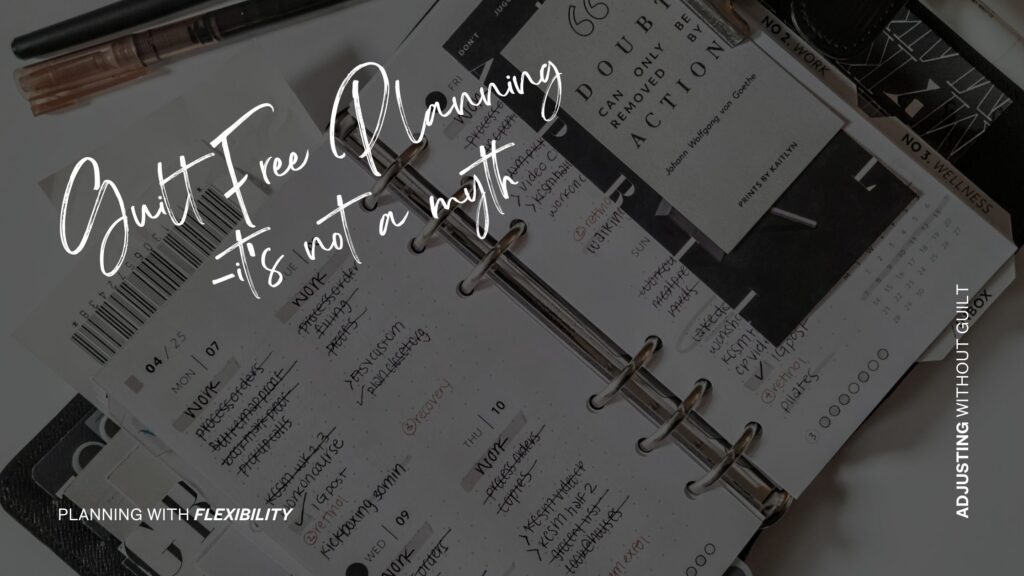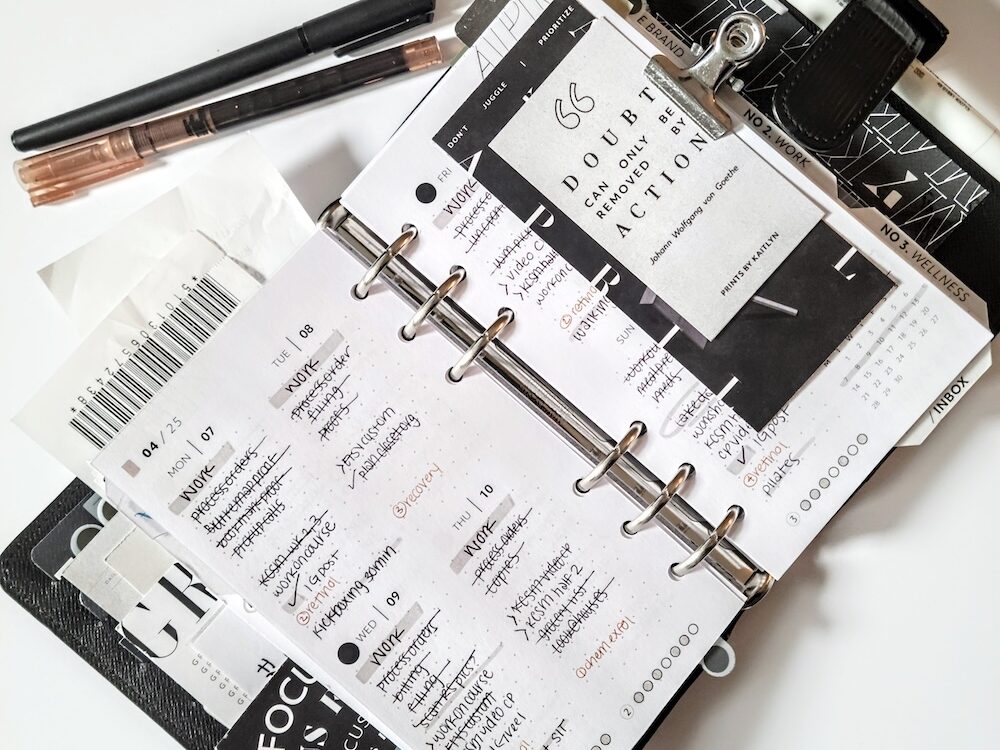
“My hot take on planning is that it is meant for moving the needle forward in your life, not to have complete control of everything all the time.”
Kaitlyn
Why rigid planning leads to frustration (and what to do instead)
Life happens and it isn’t always predictable. So it is impossible for every little thing to go according to plan. If you are planning with the expectation of everything working out perfectly, you will likely be disappointed, burnt-out, and feel like you are failing. We need to change that mindset altogether. We need to plan with flexibility and adaptability.
My hot take on planning is that it is meant for moving the needle forward in your life, not to have complete control of everything all the time. It’s meant to make you aware of your priorities, help you manage your time, decrease anxiety, and help you make progress with your goals. This cannot happen if you start your planning session with the mindset that everything will happen perfectly.
There are plenty of days / weeks when I don’t accomplish my full to-do list. But here’s how I see it: If I never made the to-do list and tried to accomplish my tasks, I wouldn’t have completed anything. Whereas making the overly ambitious to-do list led me to completing 5-6 large tasks in my week that I otherwise would never have accomplished.
Planning is a way to hold yourself accountable and take on each day with intention. It helps you prioritize your tasks, instead of just juggling them (read my previous blog post for practical ways to prioritize tasks).
The “Pivot, Don’t Quit” method for adjusting goals
If you are currently trying to work towards goals, establish healthy habits, or create new routines, but you keep falling off the wagon and quitting, you need to find a way to pivot. Ask yourself “why am I not sticking to this plan?”
Here are some examples of what could be causing you to quit and how you can pivot instead:
If you want to start working out regularly, but find yourself not even starting, figure out what the barrier is. Is the time of day not working for you? If so, try working out at a different time of day. Do you dread your workout plan? If so, try a different method of movement, one that will be more fun and feel better for you. Maybe you feel too rushed and feel like you don’t have enough time. If that’s the case, make it as easy as possible for yourself to complete the workout. Lay out your clothing in advance, gather any equipment or supplies you need, and have everything ready for your workout so you don’t waste any time.
If you are trying to eat healthier but find yourself choosing fast food, you need to prep for the coming week a full week in advance. By that I mean, gather some recipes you want to try and make a grocery list ahead of time. Get your groceries and then spend some time over the weekend meal-prepping. This way, you already have food prepared that you won’t want to waste because you spent time and money prepping it. You also won’t have to decide on a food option for your meals during the week because it will be prepped for you. I find this super helpful for me during my work week to prep lunches. I already have the food handy, I don’t have to go out and decide what to eat, and I actually get to enjoy some down-time on my lunch break. Plus I am eating a healthy meal that I feel good about.
Preparation is key when working toward any goal. You have to find ways to pivot and make decisions easier for yourself. Before you give up, choose one goal for next week and make a plan of action today. Use your planner to help hold yourself accountable. If you need to prep your workout clothing the night before, literally write this in your planner. It’s nearly impossible to remember these steps if you are relying on your memory alone.

How to balance structure & spontaneity in your schedule
I have a full-time day job that requires me to be fairly structured, but I still make my own schedule as far as getting the work done. I never know what the day will look like as far as phone calls, emails, walk-in customers, and order volume. So I like to jot down my top 3-5 priorities that need to get done each day. As long as those tasks are completed, the rest of the workday is pretty flexible and I can jump from task to task as needed. I will also write down tasks for my side job and my brand. For these tasks, I have to create some time blocks in my week and work on them incrementally. I am rarely able to check off these extra tasks the day I write them into my planner. I usually have to migrate them. But as long as I am keeping them top of mind and know when the deadline is, writing them in helps me stay on top of it.
If you’re someone who has a super structured job that you don’t need to write down tasks for, use your planner for things like adult / life tasks, deadlines, action steps for your goals, etc. You don’t have to stick to your planner 100% of the time. The purpose of the planner is to keep things top-of-mind and help you prepare for things in advance.
Here are some practical ways to balance structure and spontaneity:
Start with Anchors, Not Agendas
Instead of filling your whole day with rigid time blocks, choose 2–4 anchor points (ex: “Morning Routine,” “After Work Focus Time,” “Evening Wind Down”). Let the time between flow more naturally depending on energy and what’s happening. Structure = support, not suffocation.
Use a “Soft Schedule” System
Try flexible planning: Instead of saying “Post on Instagram at 8 PM,” try “Sometime today, write or post 1 thing.”
Build out a ‘Must-Do, Might-Do, and Mood-Based’ task list:
- Must-Do: Has a deadline or major impact
- Might-Do: Would move things forward if you have time
- Mood-Based: Creative tasks that depend on how you’re feeling
Plan Around Energy, Not Just Time
Know your natural rhythms: Are you sharper in the morning? Do you crash at 3 PM? Structure your most important work during your high-energy windows, and keep low-energy or creative/free play for the rest. This allows spontaneity to exist within a container of flow.
Creating a “Plan B” system for when things don’t go as planned
Define “Essential” vs. “Ideal”
Essential tasks are the ones that keep life and business moving forward — even if it’s just barely. These are my full-time job tasks and adulting tasks.
Ideal tasks are what you’d do in your dream schedule. For me, these are my side job and brand tasks. Yes these tasks still need to be completed – but my deadlines are more flexible for these tasks. Keep a running list of both. When your day blows up? Focus on the essential column, guilt-free.
Pre-Plan Buffer Blocks
Build intentional breathing room into your weekly plan. Block an hour or two labeled “Overflow or Catch-Up” — make this sacred time to redirect what didn’t get done. It turns “I didn’t finish this” into “I already have time set aside for this.” I typically will do this on the weekend if I need extra time because my week is already so full. But you may have a specific weekday, morning or night that you can build in this overflow time block.
Routines with Wiggle Room
Instead of a strict routine like “Write every night at 8pm,” try: “Choose one pocket of time each evening to work on business tasks — even if it’s 15 minutes.” I love this because some days I am completely drained and exhausted but I still want to make progress on my business goals. I am always surprised by how much I can accomplish in just 15 minutes. It helps me move the needle forward for the day and keeps me feeling motivated. Create flexible anchors instead of rigid schedules.
Keep Your “Why” Front and Center
On days when Plan A crashes and burns, remind yourself: “I’m building this so I can live with more freedom, not more stress.” This is so powerful for me on those really tough, long days where I wonder if working on content or working on my brand is even worth the time and energy. Having your “why” written down where you can remind yourself of it is essential to long-term growth and sticking to your goals even when the plan feels like it’s failing. You have got to remind yourself why you are doing this in the first place and why working toward that specific goal is important to you.
STAY IN TOUCH!
Follow me on instagram for more planning tips and inspiration.
Don’t forget about the monthly freebies! These are sent out monthly to email subscribers, so sign up for the newsletter and don’t miss out! Subscribers also receive exclusive offers, discount codes, and more!
Leave a Reply